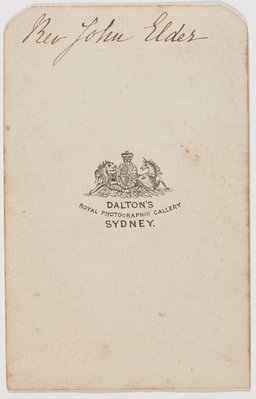-
Details
- Date
- 1863-1864
- Media category
- Photograph
- Materials used
- carte de visite
- Dimensions
- 4.4 x 3.6 cm image (irreg.); 9.0 x 5.9 cm sheet; 10.0 x 6.3 cm mount card
- Signature & date
Not signed. Not dated.
- Credit
- Purchased 2014
- Location
- Not on display
- Accession number
- 310.2014
- Copyright
- Artist information
-
Edward Dalton
Works in the collection
- Share
-
-
About
Edwin Dalton was an English portrait painter, miniaturist and prominent society photographer. He arrived in Victoria in the 1850s, possibly in search of gold, and in 1853 he was advertising his services as a portraitist. By 1854 Dalton was in Sydney, where he made portraits of colonial notables Henry Parkes, J S Dowling and Walter Lamb, which were celebrated for their naturalism. In 1857 he added daguerreotypes to his list of services, and opened his Royal Photographic Portrait Establishment in George St. Dalton’s great claim to fame was that he had instructed Queen Victoria in etching, although the letter confirming his royal connections was destroyed in a studio fire in 1862. Nonetheless, it was an achievement that drew many illustrious sitters to his studio. While initially working in daguerreotype and ambrotype, Dalton also produced stereographs and photographic mosaics and frequently embellished his images with crayon. In 1858 he advertised the ‘crayotype’ (now called a biotype), in which a paper photograph was coloured with pastels. In 1865 he sold the business to Thomas Felton, who continued to operate under Dalton’s name, and returned to England. When Dalton’s finally closed in 1870, William Freeman acquired both the premises and the negatives.
A carte de visite is a stiff card of about 10 x 6.4 cm, with an attached paper photograph, invented in 1854 by André-Adolphe-Eugène Disderi. They were introduced into Australia in 1859 by William Blackwood with albums arriving in 1860, aiding the collection and distribution of multiple cartes. Cartes were usually portraits and were made by the millions worldwide. Multi-lens, or ‘multiplying’ cameras were introduced in the 1860s, which were capable of producing from 2 to 32 images in quick succession, dramatically increasing the number of cartes de visite that could be made from a single photographic plate. They were easily reproduced by making paper contact prints from the glass plates, which were then cut and pasted to card.
-
Exhibition history
Shown in 1 exhibition
The photograph and Australia, Art Gallery of New South Wales, Sydney, 21 Mar 2015–08 Jun 2015
The photograph and Australia, Queensland Art Gallery, South Brisbane, 04 Jul 2015–11 Oct 2015

